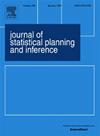受约束估计器的近似自举法
IF 0.8
4区 数学
Q3 STATISTICS & PROBABILITY
引用次数: 0
摘要
我们演示了如何对 n 个一致估计器进行统一渐近有效推断,这些估计器被定义为一个约束优化问题的解,该问题具有可能是非光滑或非凸的样本目标函数和可能是非凸的约束集。我们允许问题的解处于约束集的边界上,或随着样本量的增加而向约束集的边界漂移。我们通过将测试统计量与临界值进行比对来构建置信集,这些临界值可以从一个简单的无约束二次编程问题中获得。蒙特卡罗模拟说明了我们的方法在边界约束最大似然模型、边界约束非光滑 GMM 模型和带容量约束的条件 logit 模型中的均匀正确覆盖率。本文章由计算机程序翻译,如有差异,请以英文原文为准。
The proximal bootstrap for constrained estimators
We demonstrate how to conduct uniformly asymptotically valid inference for -consistent estimators defined as the solution to a constrained optimization problem with a possibly nonsmooth or nonconvex sample objective function and a possibly nonconvex constraint set. We allow for the solution to the problem to be on the boundary of the constraint set or to drift towards the boundary of the constraint set as the sample size goes to infinity. We construct a confidence set by benchmarking a test statistic against critical values that can be obtained from a simple unconstrained quadratic programming problem. Monte Carlo simulations illustrate the uniformly correct coverage of our method in a boundary constrained maximum likelihood model, a boundary constrained nonsmooth GMM model, and a conditional logit model with capacity constraints.
求助全文
通过发布文献求助,成功后即可免费获取论文全文。
去求助
来源期刊
CiteScore
2.10
自引率
11.10%
发文量
78
审稿时长
3-6 weeks
期刊介绍:
The Journal of Statistical Planning and Inference offers itself as a multifaceted and all-inclusive bridge between classical aspects of statistics and probability, and the emerging interdisciplinary aspects that have a potential of revolutionizing the subject. While we maintain our traditional strength in statistical inference, design, classical probability, and large sample methods, we also have a far more inclusive and broadened scope to keep up with the new problems that confront us as statisticians, mathematicians, and scientists.
We publish high quality articles in all branches of statistics, probability, discrete mathematics, machine learning, and bioinformatics. We also especially welcome well written and up to date review articles on fundamental themes of statistics, probability, machine learning, and general biostatistics. Thoughtful letters to the editors, interesting problems in need of a solution, and short notes carrying an element of elegance or beauty are equally welcome.

 求助内容:
求助内容: 应助结果提醒方式:
应助结果提醒方式:


